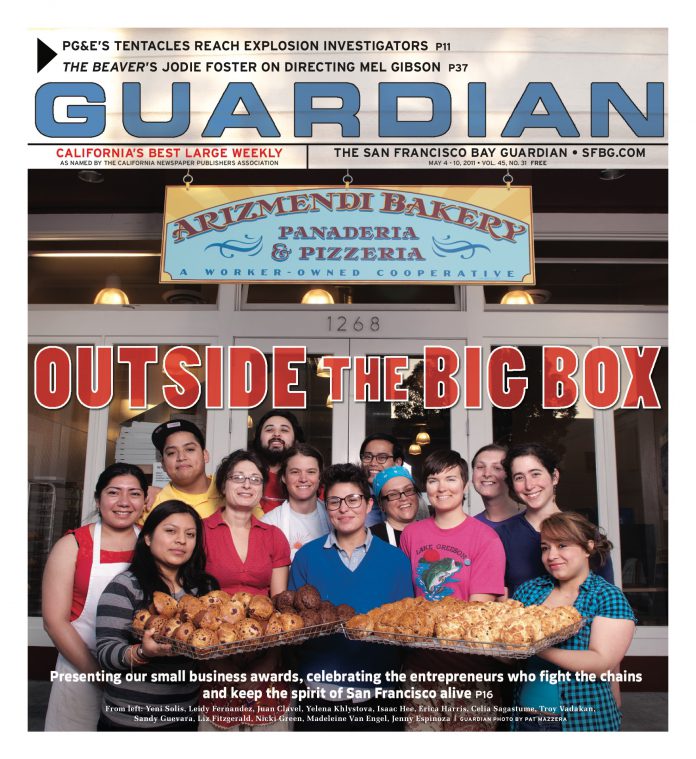CYCLING The SF Bike Coalition’s valet parking was strangely empty for a blazingly sunny Saturday event by the Ferry Building. “They’ve just been leaving their bikes around,” a bored attendant told me of the crowd assembled for the Red Bull Ride + Style fixed-gear competition. But that wasn’t out of apathy to their rides — these attendees wanted to keep their bikes close.
Candy-colored fixies were turned upside-down on their handlebars, stacked in piles with the steeds of their owners’ friends. Young men (there were a lot of young men) kept their hands firmly locked in riding position, rolling their bikes back and forth as they spoke, some times gesticulating with them for added effect. Those slim, messenger-style backpacks were much in evidence.
In the competition arena, no one strayed far from their bikes either, except for the spectacular falls that sporadically broke up the action. Strap-on fixed-gear pedals make for epic wipe-outs; one soldier was taken off the field on a stretcher.
Save for the lone female who rolled about during the event’s interminable “practice times,” all riders were male. This was about bros on bikes. Indeed, as the final race around the hazardous, hairpin track was announced between Bay Area childhood friends Jason Clary and Kell McKenzie (Clary won), the announcer took a moment to salute their relationship. “You guys have known each other since you were 14? It’s bro versus bro! Fixed-gear nation!”
Competitive fixed-gear racing is, relatively speaking, a nascent addition to the legion of bone-cracking thrill fests enjoyed by extreme sports fans. The sport’s lexicon is borrowed from the death-defying ride tactics of gonzo bike messengers, a profession that has to sprint to keep up with e-mail and 3-D projection technology to stay salient for corporate America.
San Francisco is one of the messenger bike meccas. The city has given birth to some epically fly-terrifying fixie films — guys slaloming down from Twin Peaks, diving into traffic, holding onto buses for acceleration, basically using the ridiculous speed you can achieve on a fixed- gear bike for pure chaos (in the eyes of the pedestrian, surely).
But street stunts do not a competitive sport make. On Saturday, it was apparent that everyone was trying to figure out just what Ride + Style meant. The week before the event, the Guardian interviewed Austin Horse, one of New York City’s best-known bike messengers, by e-mail.
“Nobody knows what to expect about Ride N Style,” he wrote. “It’s very mysterious, but the riders know it’s going to be a challenging and compelling event because it’s coming from Red Bull. [Editor’s note: Apparently Red Bull’s sponsorship is a big deal. Red Bull also sponsored a downhill bike race through a Brazilian favela, the aerodynamic inanity of Flutag, and your most jittery friend in college who had a dorm room full of Red Bull crates. Remember that guy?] The result is that all the riders are a little more anxious about this race than other events. What we do know is that it’s gonna be a sprint with features some guys aren’t going to be comfortable with. It’s a little scary.”
The second half of the day was given over to what was billed as the most cutting edge part of the competition: the freestyle contest. Covered in sherbet colors, spiders, geometric whorls, and playing card designs, they looked every bit the background for an extreme sports tournament.
“Only rarely have events invested in features tailored to the constraints and potential of this type of riding,” Horse says. When the cameras are off “people practice wherever they can — skate parks and street spots.”
In San Francisco, one of the most reliable spots to watch good fixed-gear freestyling is in the Harry Bridges Plaza, the strip of asphalt between the Ferry Building and where Ride + Style was erected in the more ample Justin Herman Plaza. You can go out to Harry Bridges at dusk most days and see people hopping their bikes off the ground, spinning in the air, twerking their handlebars, riding backward in tight figure eights, and stopping on dimes.
But the ramps took it up a notch — so up that spectators began to compare the competition to those of BMX bikes, which can catch a lot more air than fixed gears. It wasn’t a coincidental connection: some of the competitors announced on the microphone that they were usually on a BMX, and Jeremy Witek, the lead designer of the ramps, told me during the construction phase that this was the first time he’d been asked to make structures like these for a fixed-gear competition.
There were some hands-down highlights of the freestyle portion — Kohei “Kozo” Fuji flew in from Osaka to bust the first fixed-gear back flip in international competition. But many of the routines seemed strangely suited for their setting. The beauty of the fixed-gear lies in its simplicity — one pump of the legs, one rotation of the wheels, the easy mathematics of human body and machine.
But the novelty of seeing these lifestyle bikes thrust into the bright lights and loud announcers of the X Games variety wasn’t lost on those least jaded of San Franciscans — the Embarcadero tourists. Washing my hands in the Embarcadero Center bathroom, I heard a young woman essentially ask her mom what the hell this crazy city of bikes is up to. “Does San Francisco always have this?”
Girl, it does now.

